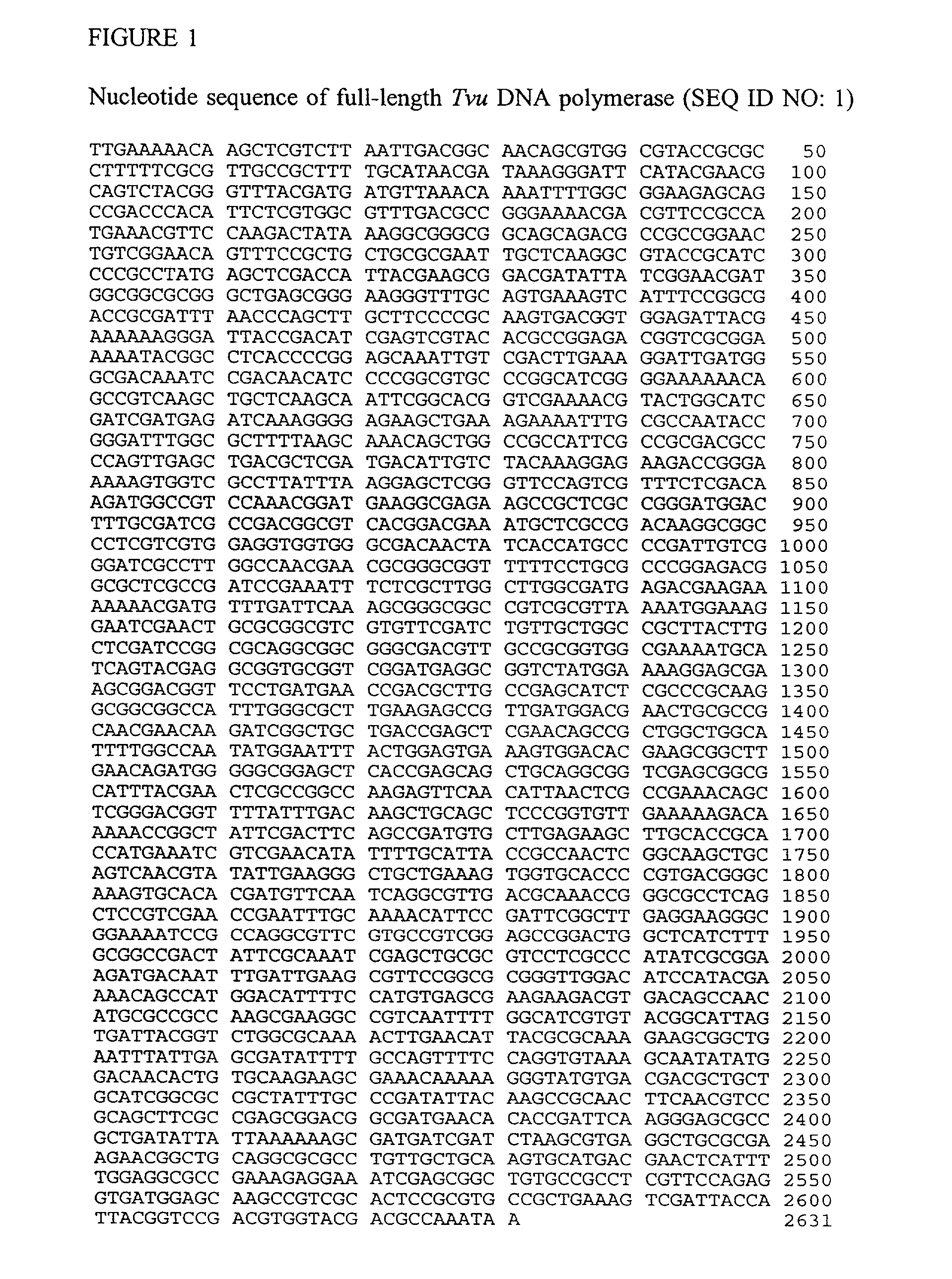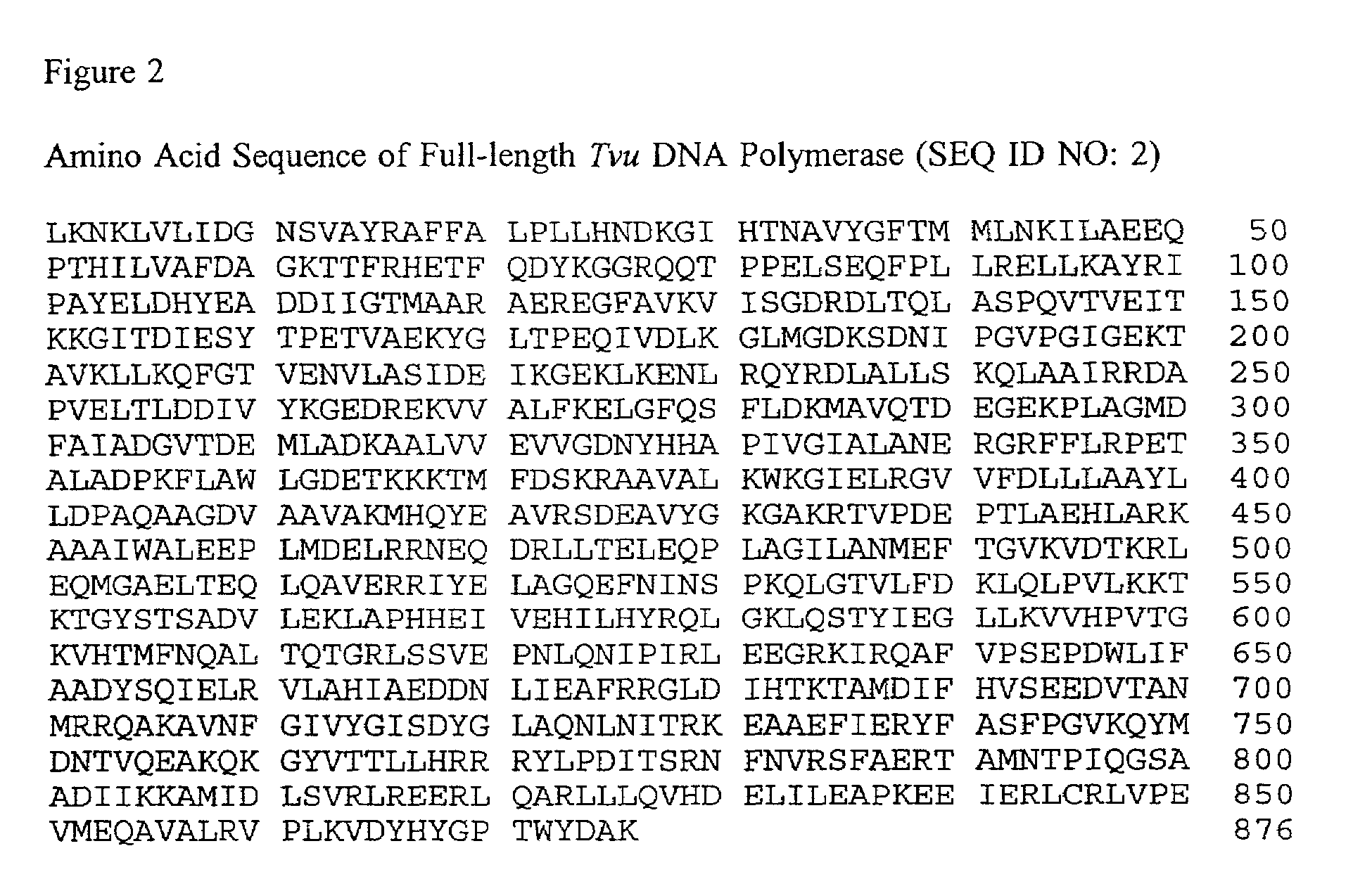Bacillus stearothermophilus reverse transcription compositions and kits
a technology of reverse transcription and composition, applied in the field of can solve the problems of difficult reverse transcription difficult detection of rna molecules containing secondary structure, and anomalous reverse transcription results
- Summary
- Abstract
- Description
- Claims
- Application Information
AI Technical Summary
Problems solved by technology
Method used
Image
Examples
example 1
Purification of Tvu DNA Polymerase
[0170]This example describes the purification of native T. vulgaris (Tvu) DNA polymerase. Tvu cells were obtained from the ATCC (Accession Number 43649). This purified polymerase was then used in the experiments represented in Examples 2 through 10. One milliliter from the frozen seed vial was thawed and inoculated into 1 liter Luria broth. The medium was supplemented with 10 ml of 20% glucose. The culture was grown for 15 hours on a shaker at 55° C. and 250 rpm. Five hundred milliliters of this culture were added to 17.5 liters medium in a 20-liter fermenter. The culture was grown at 55° C. The culture growth was monitored spectrophotometrically at 580 nm and measured based on wet weight of cell pellets from 40 ml of broth. After 4.75 hours, the contents were chilled and harvested using a CEPA tubular bowl centrifuge. The net yield of cell paste was 69.0 g. The cell paste was stored in a freezer at −85° C., until purification of Tvu DNA polymerase ...
example 2
DNA Polymerization Activity Assay
[0175]Activity of native, thermostable Tvu DNA polymerase purified as described in Example 1 was assayed by incorporation of radiolabeled dTTP into nicked and gapped (i.e., activated) calf thymus DNA prepared as described below. One unit of thermostable DNA polymerase is defined as the amount of enzyme required to catalyze the incorporation of 10 nmol of dNTP into an acid-insoluble form in 30 minutes at 74° C. The reaction conditions comprised: 50 mM Tris-HCl (pH 9.0 at 25° C.), 50 mM NaCl, 10 mM MgCl2, 12 μg activated calf thymus DNA, 0.2 mM dATP, 0.2 mM dGTP, 0.2 mM dCTP, 0.2 mM dTTP (Promega, U1240), and 1 μCi of 3HdTTP (Amersham, #TRK.424) per 50 μl reaction.
[0176]The reaction components were assembled at room temperature. Samples suspected of containing polymerase activity were added (5 μl containing 0.05 to 0.5 units) and the tube was incubated at 74° C. for 30 minutes. Then, 50 μl aliquots were removed at 6, 9, 12, and 15 minutes and placed in...
example 3
Comparison of RT Activity of Thermostable DNA Polymerases in the Presence of Mg2+ or Mn2+ Ions
[0178]This example describes the determination of the reverse transcriptase activity of several different DNA polymerases in the presence of either Mg2+ or Mn2+ ions. In these experiments, a reverse transcription (RT) reaction mix was used. The final concentration of each component in a reaction was: 10 mM Tris-HCl (pH 8.3), 90 mM KCl, 0.5 mM dTTP (Promega, U123A), 0.25 mM polyriboadenylate, 0.025 mM oligodeoxythymidylate (Supertechs 111020A), and 0.25 μCi 3HdTTP (Amersham Life Science, catalog #TRK.424) in 50 μl reaction volume.
[0179]Each 45 μl aliquot of the RT reaction mix was mixed with 2 μl (10 units) of one of the DNA polymerases, and 1 μl of either 50 mM MnCl2 or 50 mM MgCl2. The solutions were then incubated at 70° C. for 15 minutes. Reactions were stopped by placing them on ice. native Taq, sequencing grade Taq (sTaq), and Tth were from Promega (M166, M203, M210 respectively), Tne ...
PUM
| Property | Measurement | Unit |
|---|---|---|
| temperature | aaaaa | aaaaa |
| temperatures | aaaaa | aaaaa |
| pH | aaaaa | aaaaa |
Abstract
Description
Claims
Application Information
 Login to View More
Login to View More - R&D
- Intellectual Property
- Life Sciences
- Materials
- Tech Scout
- Unparalleled Data Quality
- Higher Quality Content
- 60% Fewer Hallucinations
Browse by: Latest US Patents, China's latest patents, Technical Efficacy Thesaurus, Application Domain, Technology Topic, Popular Technical Reports.
© 2025 PatSnap. All rights reserved.Legal|Privacy policy|Modern Slavery Act Transparency Statement|Sitemap|About US| Contact US: help@patsnap.com



